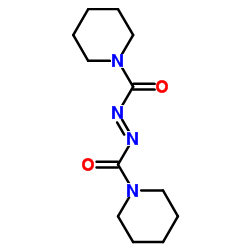1,1'-(偶氮二羰基)二哌啶

1,1'-(偶氮二羰基)二哌啶结构式

|
常用名 | 1,1'-(偶氮二羰基)二哌啶 | 英文名 | 1,1'-(azodicarbonyl)-dipiperidine |
|---|---|---|---|---|
| CAS号 | 10465-81-3 | 分子量 | 252.313 | |
| 密度 | 1.3±0.1 g/cm3 | 沸点 | 366.4±25.0 °C at 760 mmHg | |
| 分子式 | C12H20N4O2 | 熔点 | 132-136 °C(lit.) | |
| MSDS | 美版 | 闪点 | 175.4±23.2 °C | |
| 符号 |

GHS07 |
信号词 | Warning |
|
Copper salt catalyzed addition of arylboronic acids to azodicarboxylates.
J. Org. Chem. 70 , 8631, (2005) The addition of arylboronic acids 1 to azodicarboxylates 2 in the presence of a catalytic amount of a copper salt under mild reaction conditions gives aryl-substituted hydrazines 3 in high yields. The reaction is tolerant of a wide variety of functional group... |
|
|
Structure--activity relationships of 1beta-methyl-2-(5-phenylpyrrolidin-3-ylthio)carbapenems.
Bioorg. Med. Chem. 10 , 1595, (2002) Structure--activity relationship studies of 1beta-methyl-2-[(3S,5R)-5-(4-aminomethylphenyl)pyrrolidin-3-ylthio]carbapenems, especially those pertaining to the relationship between antibacterial activity and side-chain structure were conducted. These studies s... |
|
|
Radiosensitization, thiol oxidation, and inhibition of DNA repair by SR 4077.
Radiat. Res. 113 , 346, (1988) The mechanism of radiosensitization by diazenedicarboxylic acid bis(N),N-piperidide (SR 4077), a less toxic analog of diamide, was studied using Chinese hamster ovary cells. SR 4077 gave an average SER of 1.58 for postirradiation incubations of 0.5, 1.0, or 2... |
|
|
Radiosensitization by diamide analogs and arsenicals.
Int. J. Radiat. Oncol. Biol. Phys. 12(8) , 1533-5, (1986) Several analogs of the glutathione (GSH) oxidizing reagent diamide [diazenedicarboxylic acid bis(N,N'-diethylamide)] were tested as radiosensitizers of aerobic cells. In general, radiosensitization correlates with the rate of reaction with cellular reducing a... |
|
|
Novel concepts in modification of radiation sensitivity.
Int. J. Radiat. Oncol. Biol. Phys. 29(2) , 249-53, (1994) To determine whether biological effects of radiation, such as apoptosis, that differ from classical clonogenic cell killing, can be modified with agents that would not be expected to modify classical clonogenic cell killing. This would expand the range of pot... |
|
|
Dougherty, J.M.; et al.
Tetrahedron 61 , 6218, (2005)
|
|
|
Tetrahedron Lett. 34 , 1639, (1993)
|